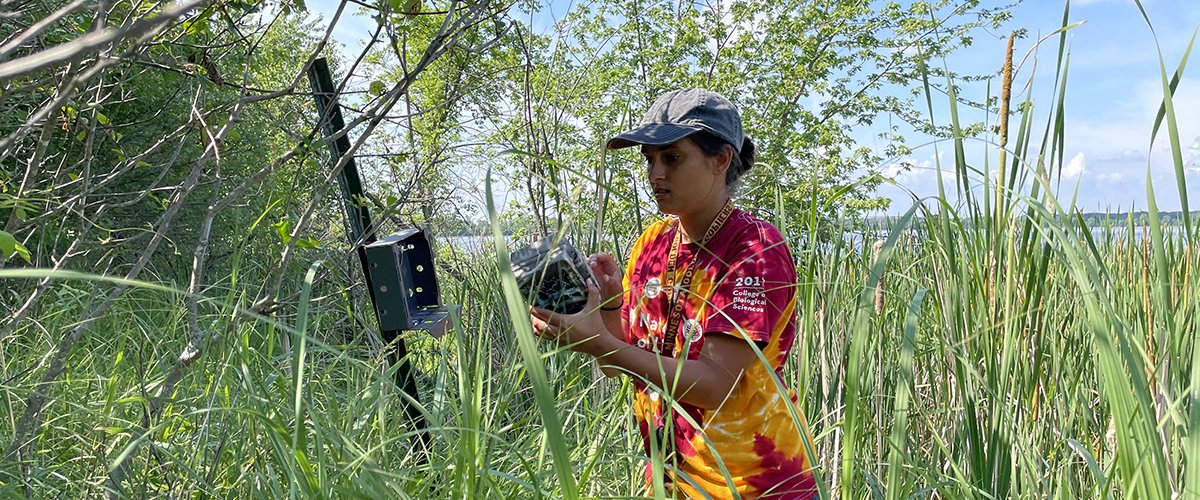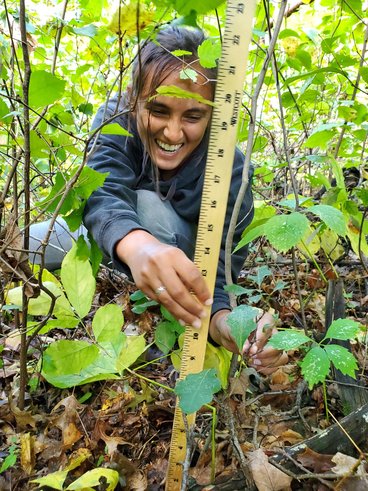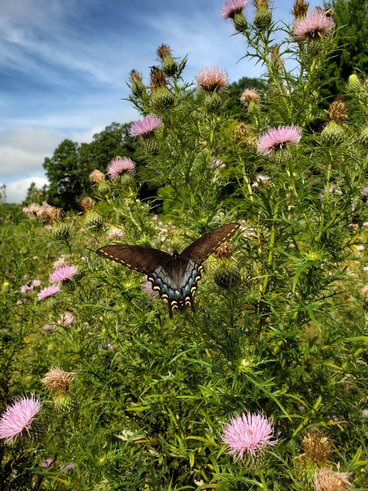
A passion for pollinators
Through her scientific research, entomology graduate student Maya Vellicolungara works to understand and increase bumblebee and butterfly abundance and diversity

LOUISA SMITH, AGRICULTURAL COMMUNICATION & MARKETING, BS '25
Maya Vellicolungara has a passion for pollinators. A current entomology graduate student at the University of Minnesota, she is beginning her first field session with the Dan Cariveau Native Bee Lab on the Twin Cities campus in St. Paul this summer.
In this role, she hopes to gather high quality data on bumblebee and butterfly abundance and diversity so she can make recommendations about the types of practices that work best for pollinators. “It would also be awesome to compare the pollinator, grassland bird, and plant data to see if there are consistent responses to the different seed mixes,” she said.

Vellicolungara’s research focuses on bumblebee and butterfly abundance and diversity on Conservation Reserve Program (CRP) lands. “CRP is a program that farmers can enroll in, where they set aside a portion of their land and install plants, “ explains Vellicolungara. She will visit CRP plantings that were established using either low or high cost seed mixes, comparing the pollinator communities on each. “This project is unique because it is a collaboration between three labs and we will be collecting data on grassland birds, plants, and pollinators,” she said. “The work I do is important because it aims to determine which CRP practices are most cost effective, which will help inform future CRP decision making.”
With this new research opportunity, Vellicolungara said she is looking forward to spending time outdoors in the untouched remnant prairies (prairies that have not been plowed or converted to agriculture). “A remnant prairie in full bloom is a super beautiful thing, and it isn’t something that many people get to see due to the limited amount of remnant prairies remaining,” she said. She also looks forward to learning how to identify different species of birds, insects, and plants.
Before working with the Bee Lab, Vellicolungara participated in a variety of undergraduate research. She worked at the U of M’s Animal Communication Laboratory as a directed researcher, studying frog species. “I got to wade out into lakes and ponds late at night and catch mating pairs of frogs, bringing them back to the lab for acoustic sexual selection experiments,” she said.
Later she worked as an intern in the Isbell Biodiversity Lab. “I assisted researchers with data collection for many different projects, most of which focused on how anthropogenic changes like habitat fragmentation and elevated CO2 levels influence prairie plant communities. I also got to do some work with the bison herd that they have, which was a really special experience,” she said.

Vellicolungara also had the opportunity to conduct an individual research project on the effects of agricultural field abandonment and burning on insect abundance. Most recently, she worked as a wildlife technician for Dacota County, monitoring surveys for different animals including marsh birds, bats, frogs/toads, turtles, small mammals, and bumblebees and coordinating their public wildlife monitoring volunteer program. Her favorite part of this research has been being in the field and learning about different organisms every field session, collecting data that makes a difference and tells a story. “These positions helped me determine that I truly love doing field work and working with creatures of all kinds,” she said.
As an undergraduate, Vellicolungara started off as a biology major before switching to a degree in ecology, evolution, and behavior. She found interest in ecology after being introduced to its “creative and less rigid” approach in her classes. She also volunteered at the UMN Insect Collection, which sparked more interest in insects.
In the future, Vellicolungara hopes to work for a government agency or nonprofit as an ecologist. “Research with the Cariveau Native Bee Lab has already helped me grow my network by communicating with staff from many different organizations to learn more about pollinator identification and how CRP works,” she said. “This project is also giving me more confidence in conducting research and science communication, which will be important when I am looking for jobs. In whatever work I do, I want to make a real impact by contributing to the conservation of native plants and animals.”

Vellicolungara believed that people should care about bees and pollinators not just for the ecosystem services that they can provide, but also for the ecological functions and intrinsic values that they hold. She explains that many species of bumblebees are in decline and their geographic ranges are contracting significantly due to many factors including pesticide use, climate change, and resource availability.
She also urges the public to learn more about their important role in supporting the preservation of pollinators. “People can help by voting for lawmakers that take the decline of pollinators seriously and have conservation goals as a priority,” she said. “In addition, there are some programs such as CRP and Lawns to Legumes, which help people implement pollinator habitat on their land. Planting native flowering species in your backyard can provide vital resources for pollinators that are living in human-dominated landscapes.” Vellicolungara shares a list of resources to help individuals implement residential pollinator habitats.
Vellicolungara has a clear image of what she would like to see happen for pollinators in the future. “I would like to see changes in the law that better protect bees and pollinators through limiting the application frequency and type of pesticides that are allowed. It would also be great if lawmakers made it a priority to increase the amount of prairie habitat, since agriculture has replaced prairie in the majority of Minnesota. This will only happen through public pressure and support.”





